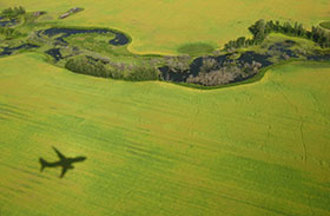
Translations
Produção SAF de 2022 aumenta 200%, mas são necessários mais incentivos para atingir zero emissão líquida (pdf)
La producción de SAF se incrementa hasta el 200% en 2022 – Se necesitan más incentivos para alcanzar el cero neto (pdf)
国际航协:2022 年SAF产量增200% 需更多生产激励措施实现净零碳排放 (pdf)
Augmentation de 200 % de la production de SAF en 2022 – Il faut des mesures incitatives supplémentaires pour atteindre l’objectif Zéro Net (pdf)
ارتفاع مستويات إنتاج وقود الطيران المستدام بواقع 200% خلال عام 2022 مع ضرورة اعتماد المزيد من الحوافز لتعزيز الإنتاج والوصول إلى الحياد المناخي (pdf)
Geneva – The International Air Transport Association (IATA) estimates that Sustainable Aviation Fuel (SAF) production will reach at least 300 million liters in 2022—a 200% increase on 2021 production of 100 million liters. More optimistic calculations estimate total production in 2022 could reach 450 million liters. Both scenarios position the SAF industry on the verge of an exponential capacity and production ramp-up toward an identified tipping point of 30 billion liters by 2030, with the right supporting policies.
Airlines are committed to achieve net zero CO2 emissions by 2050 and see SAF as a key contributor. Current estimates expect SAF to account for 65% of the mitigation needed for this, requiring a production capacity of 450 billion liters annually in 2050.
Having agreed to a Long Term Aspirational Goal (LTAG) on climate at the 41st Assembly of the International Civil Aviation Organization (ICAO) in October 2022, governments now share the same target for aviation’s decarbonization and interest in the success of SAF.
“There was at least triple the amount of SAF in the market in 2022 than in 2021. And airlines used every drop, even at very high prices! If more was available, it would have been purchased. That makes it clear that it is a supply issue and that market forces alone are insufficient to solve it. Governments, who now share the same 2050 net zero goal, need to put in place comprehensive production incentives for SAF. It is what they did to successfully transition economies to renewable sources of electricity. And it is what aviation needs to decarbonize,” said Willie Walsh, IATA’s Director General.
To date, over 450,000 commercial flights have been operated using SAF, and the growing number of airlines signing offtake agreements with producers sends a clear signal to the markets that SAF is needed in larger quantities, and so far in 2022, around 40 offtake agreements have been announced.
Incentive-based policies
Until we have commercialized options for alternative power sources such as hydrogen, all of aviation’s SAF supply will be derived from biofuel refineries. These refineries produce renewable biodiesel, biogas, as well as SAF and their refining capacity is set to grow by over 400% by 2025 compared to 2022. The challenge for aviation is to secure its supply of SAF from this capacity. And to do that successfully governments need to put in place SAF production incentives similar to what is already in place for biogas and biodiesel.
SAF Production To-Date
| Year | 2019 | 2020 | 2021 | 2022E |
|---|---|---|---|---|
| Estimated SAF Output (Million Liters) | 25 | 62.5 | 100 | 300-450 |
For more information, please contact:
Corporate Communications
Tel: +41 22 770 2967
Email: corpcomms@iata.org
Notes for Editors:
- IATA (International Air Transport Association) represents some 360 airlines comprising over 80% of global air traffic.
- You can follow us on X for announcements, policy positions, and other useful industry information.
- Fly Net Zero

